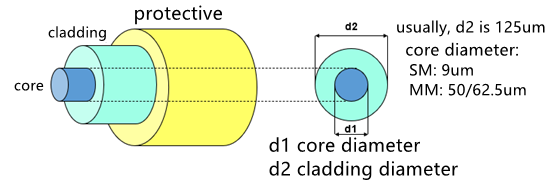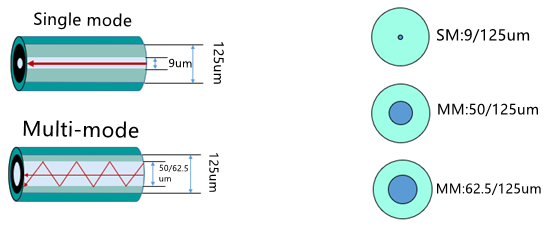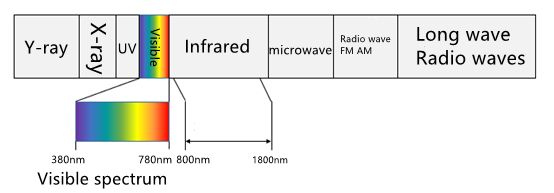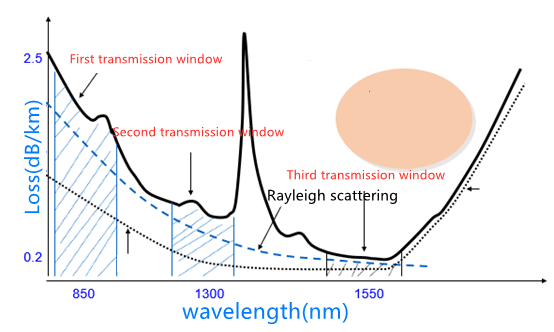Optical fiber related knowledge
Publish:Box Optronics Time:2022-09-08 Views:996
Optical fiber is the abbreviation of optical fiber, and its structure is shown in the figure: the inner layer is the core, which has a high refractive index, and is used to transmit light; the middle layer is the cladding, and the refractive index is low, forming a total reflection condition with the core; the outermost The layer is a protective layer to protect the optical fiber.
 Classification of optical fiber:
According to the number of transmission modes in the optical fiber, the optical fiber can be divided into single mode fiber(SMF) and multi-mode fiber (MMF).
Classification of optical fiber:
According to the number of transmission modes in the optical fiber, the optical fiber can be divided into single mode fiber(SMF) and multi-mode fiber (MMF).
 Light wavelength
The nature of light is electromagnetic waves, and the visible light waves are a very small band in the electromagnetic spectrum, and its wavelength range is between 380 nm and 780 nm. The wavelength of optical fiber communication is between 800nm and 1800nm, which belongs to the infrared band. 800nm to 900nm is called short wavelength, and 1000nm to 1800nm is called long wavelength. But up to now, the most commonly used wavelengths in optical fibers are 850nm, 1310nm and 1550nm.
Light wavelength
The nature of light is electromagnetic waves, and the visible light waves are a very small band in the electromagnetic spectrum, and its wavelength range is between 380 nm and 780 nm. The wavelength of optical fiber communication is between 800nm and 1800nm, which belongs to the infrared band. 800nm to 900nm is called short wavelength, and 1000nm to 1800nm is called long wavelength. But up to now, the most commonly used wavelengths in optical fibers are 850nm, 1310nm and 1550nm.
 Three "windows" of optical fiber communication
Short wavelength window, the wavelength is 850nm
Long wavelength window, wavelengths are 1310nm and 1550nm
At a wavelength of 850nm, the loss is about 2dB/km; at a wavelength of 1310nm, the loss is 0.35dB/km; at a wavelength of 1550nm, the loss can be reduced to 0.20dB/km.
Three "windows" of optical fiber communication
Short wavelength window, the wavelength is 850nm
Long wavelength window, wavelengths are 1310nm and 1550nm
At a wavelength of 850nm, the loss is about 2dB/km; at a wavelength of 1310nm, the loss is 0.35dB/km; at a wavelength of 1550nm, the loss can be reduced to 0.20dB/km.
 Fiber loss
Optical fiber loss is an important indicator of optical fiber transmission and has a decisive influence on the transmission distance of optical fiber communication. In communication, it is customary to use the unit dB to express the loss of the optical fiber.
Optical fiber loss coefficient: the attenuation value of optical signal power per kilometer of optical fiber. Unit: dB/km
In the 1310nm window, the loss coefficient of G.652 fiber is 0.3~0.4dB/km
In the 1550nm window, the loss coefficient of G.652 fiber is 0.17~0.25dB/km
There are many reasons why optical fiber attenuates optical signals. The main ones are: absorption attenuation, including impurity absorption and intrinsic absorption; scattering attenuation, including linear scattering, nonlinear scattering, and structural incomplete scattering; other attenuation, including microbending attenuation, etc. The most important one is the attenuation caused by the absorption of impurities.
Fiber loss
Optical fiber loss is an important indicator of optical fiber transmission and has a decisive influence on the transmission distance of optical fiber communication. In communication, it is customary to use the unit dB to express the loss of the optical fiber.
Optical fiber loss coefficient: the attenuation value of optical signal power per kilometer of optical fiber. Unit: dB/km
In the 1310nm window, the loss coefficient of G.652 fiber is 0.3~0.4dB/km
In the 1550nm window, the loss coefficient of G.652 fiber is 0.17~0.25dB/km
There are many reasons why optical fiber attenuates optical signals. The main ones are: absorption attenuation, including impurity absorption and intrinsic absorption; scattering attenuation, including linear scattering, nonlinear scattering, and structural incomplete scattering; other attenuation, including microbending attenuation, etc. The most important one is the attenuation caused by the absorption of impurities.




